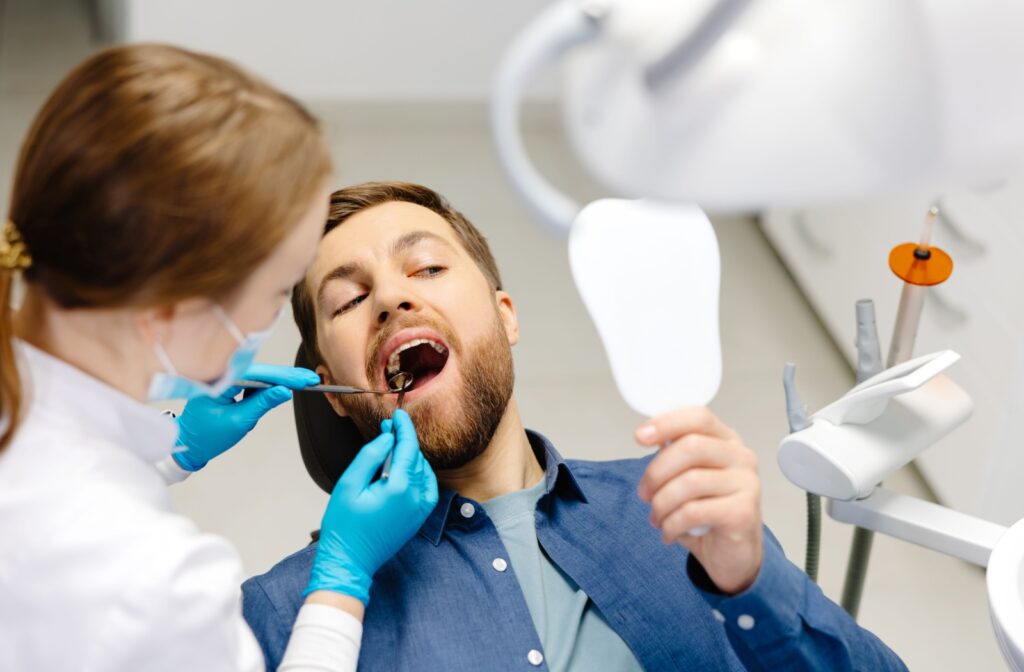Growing up, our parents were in charge of making our dental appointments. Getting pulled out of school early to go to the dentist was something you could lord over your peers, as it might let you miss that one class that always made you fall asleep.
However, making your own dental appointments as an adult isn’t so easy. Life gets busy and responsibilities pile up. But keeping up with regular cleanings is essential for your oral—and overall!—health.
You should get your teeth cleaned at least every six months, but this can vary based on your individual needs—such as if you’re prone to cavities or at risk for gum disease.
The Ideal Frequency for Dental Exams & Cleanings
One size doesn’t fit all when it comes to dental cleaning schedules. Although bi-annual visits are widely prescribed, individual needs may vary. Factors such as your oral hygiene routine, diet, and genetics all play a role in determining how often you should see your dentist.
Regular dental exams and cleanings serve as preventive measures. Visiting your dentist twice yearly is sufficient for maintaining healthy teeth and gums. However, people with specific conditions, like gum disease or a history of cavities, may need to visit more frequently.
If you need more clarification about your personal needs, consult with your dentist. They can create a personalized cleaning schedule aligning with your oral health status, ensuring you receive the best care.
The Importance of Professional Teeth Cleaning
Professional teeth cleaning offers benefits beyond what your toothbrush can achieve. This is crucial for preventing gum disease, tooth decay, and other oral health issues.
During a cleaning, your dental hygienist removes plaque and tartar that regular brushing and flossing can’t eliminate. Plaque is a sticky film of bacteria that forms over time on your teeth. If not removed, it hardens into tartar, which can only be removed by a dental professional. Regular cleanings help prevent tartar buildup, reducing your risk of cavities and gum disease.
Many people don’t realize how much of an impact dental cavities and gum disease can have on their overall health. Bacteria from your mouth can migrate to other parts of your body, particularly to your bloodstream, which can cause inflammation, heart disease, cancer, and diabetes.
Beyond health benefits, cleanings can enhance your smile’s appearance. Removing surface stains and polishing your teeth restores their natural shine, leaving you with a brighter, more confident smile.
What Happens During a Teeth Cleaning?
Dental anxiety is perfectly normal, but understanding what occurs during a dental cleaning can ease your apprehension. The process typically involves examining, cleaning, polishing, and flossing your gums and/or teeth and is generally done in under an hour.
- Examination. Your dentist or hygienist will examine your mouth for signs of oral health issues. They’ll check for cavities, gum disease, and other concerns that may require attention. This initial assessment ensures that any potential problems are addressed promptly.
- Cleaning (or Scaling). Scaling removes plaque and tartar from your teeth. Using specialized tools, your hygienist will carefully clean above and below the gum line, eliminating the hardened deposits of tartar that contribute to oral health issues.
- Polishing & Flossing. Polishing smooths the surface of your teeth, making it harder for plaque to adhere. Flossing removes debris and plaque between teeth, ensuring a thorough cleaning.

Maintaining Your Teeth Between Cleanings
Keeping your teeth healthy between appointments is essential for oral health. A consistent oral hygiene routine can help prevent issues and ensure your smile stays bright.
- Brush at least twice daily using a fluoride toothpaste for at least two minutes to remove plaque and bacteria.
- Floss daily to clean between teeth and remove debris your toothbrush can’t reach.
- Scrape your tongue with a scraper or the back of your toothbrush to help remove more debris, bacteria, and dead cells.
- Use a quality mouthwash daily to remove harmful bacteria and keep your breath fresh.
- Limit sugary and acidic foods, which contribute to tooth decay and erosion.
- Eat a balanced diet of fruits, vegetables, and whole grains to support strong teeth and gums.
- Drink water.
How Long Can You Go Without a Dental Cleaning?
While skipping one cleaning may not result in immediate harm, the longer you wait, the greater your risk of oral health issues. Regular cleanings prevent cavities and gum disease, so putting them off could lead to more significant problems. Going without cleaning for extended periods allows plaque and tartar to build up, providing a breeding ground for bacteria. If left unchecked, this can result in cavities, gum disease, and even tooth loss.
If you’ve missed a cleaning or it’s been a while since your last visit, schedule an appointment promptly. Your dentist can assess your oral health and help you get back on track with regular care.
Are There Downsides to Frequent Professional Cleanings?
While regular cleanings are beneficial, overdoing it can have drawbacks. Frequent cleanings may lead to gum irritation or sensitivity, especially if your oral hygiene is already exemplary.
Excessive cleaning can cause gums to become sore or irritated. If your teeth and gums are healthy, scheduling cleanings every two to three months may be unnecessary. Over-cleaning can also wear down the enamel, potentially increasing sensitivity to hot and cold temperatures.
Been a While? Schedule Your Next Appointment Today!
Understanding the ideal frequency for exams and cleanings ensures your oral health remains in top shape. Remember, your dentist is your partner in this journey. Their mission is to provide you with personalized guidance to keep your teeth and gums healthy.
Dentistry on Danforth understands that taking care of oral health is a preventative measure for good overall health. Contact us today to schedule your next appointment and see the dental difference we make by thoroughly understanding your unique needs.


